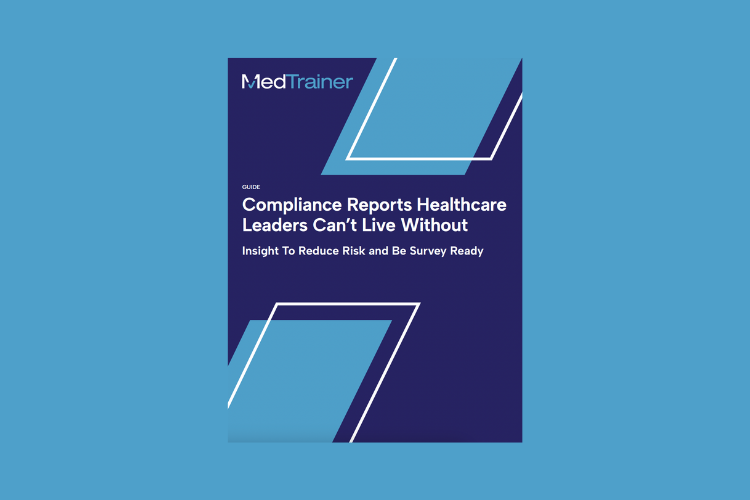Occupational Safety and Health Administration (OSHA) regulations and the Health Insurance Portability and Accountability Act (HIPAA) play a key role in guiding healthcare operations. It’s why OSHA and HIPAA training requirements are among the most important.
OSHA regulations maintain safe, healthy working conditions through standards that require continuous training, reporting, and the development of policies and procedures.
HIPAA protects the privacy and security of individuals’ health information. Training ensures all healthcare workers understand the standards required for healthcare providers and insurers to protect and handle personal health information.
Here are answers to the most common questions related to OSHA and HIPAA training requirements, as well as ideas for maintaining OSHA and HIPAA compliance.
The Importance of Meeting OSHA and HIPAA Training Requirements
Proper understanding of and compliance with OSHA and HIPAA regulations are essential for several reasons, including:
- To ensure the safety and well-being of patients and employees
- To prevent costly fines and legal action
- To protect the organization’s reputation and build trust with patients
HIPAA training is crucial for healthcare employees to understand how to properly handle sensitive patient information. This includes how to protect patient privacy, access and transmit electronic health records securely, and respond to patient information breaches.
In the healthcare industry, OSHA standards are critical because employees risk exposure to potentially infectious materials, hazardous chemicals, and physical hazards, such as slips, trips, and falls. OSHA training helps employees understand how to identify and prevent these hazards and how to respond to emergencies.
A comprehensive healthcare training program includes courses that meet HIPAA and OSHA regulations, provides the required tracking, and is fueled by the results of your organization’s risk analysis.
HIPAA and OSHA Compliance Training FAQ
Investing in employee training can ensure that your organization fully complies with OSHA and HIPAA regulations — and, ultimately, provide patients with the highest level of care. These are some of the most common questions on OSHA and HIPAA compliance training, along with MedTrainer answers.
1. How often does HIPAA and OSHA training need to be repeated?
OSHA requires annual training for all employees, and new hires must complete training within ten days of hire.
HIPAA requires training for all new employees “within a reasonable period of time,” when there is a material change in policies and procedures, and when a security risk analysis (SRA) indicates a need for training. Many accrediting agencies recommended that training is refreshed annually. A healthcare-specific learning management system (LMS) offers a wide range of HIPAA courses that can be assigned as refreshers.
2. Who is required to complete the training?
OSHA training is mandatory for all employees, including doctors, nurses, receptionists, and part-time employees.
HIPAA training is compulsory for all employees of the healthcare organization. It is also a good idea to have business associates and vendors complete HIPAA training as well.
3. How long does training take to complete?
OSHA training requirements vary by role within the healthcare organization, so some roles may be able to complete two to three hours of training, while others need to complete more. For example, employees who come into contact with blood or other potentially infectious materials must complete bloodborne pathogen training annually. Employees who come into contact with hazardous substances must complete annual training on these hazards.
HIPAA doesn’t specify a particular length of training, but no employee can receive proper training for OSHA and HIPAA in just a few minutes.
Many OSHA and HIPAA training topics are among MedTrainer’s most popular courses for compliance:
- Health Insurance Portability and Accountability Act (HIPAA)
- General Safety Orientation
- Hand Hygiene
- Active Shooter Training
- Bloodborne Pathogens (BBP)
- Personal Protective Equipment (PPE)
- Disaster Preparedness
- Hazardous Communication and Chemical Safety (HAZCOM) GHS Standard
- Fire Safety and Fire Extinguisher Types
- HIPAA Social Media and Texting Compliance
5. Are we required to keep proof of training? If so, what documentation is needed?
Yes, both HIPAA and OSHA require documentation. Training records should include dates, content, names and qualifications of trainers, and names and job titles of attendees. During an OSHA inspection, you may be asked to show proof that all employees completed fire safety training. Using a LMS can make this task much easier since course completion is automatically tracked.

Build compliance and credentialing reports that surface critical insights and keep you survey ready.
6. Is there a penalty for not maintaining compliance?
Yes, OSHA and HIPAA can issue penalties for non-compliance.
OSHA penalties can range from $0-$161,000 per violation.
HIPAA penalties can go up to $1.5 million depending on the provision of the HIPAA violation.
7. What are some examples of OSHA and HIPAA violations?
Common OSHA Violations
- Failure to implement and maintain an exposure control plan
- Failure to provide proper training
- Failure to engineer out hazards or ensure hand washing
- Poor housekeeping practices
- Failure to maintain a written hazard communication program
- Failure to make the Hepatitis B vaccination available
- Failure to prepare exposure determinations
- Failure to use personal protective equipment
- Failure to train employees under the hazard communication standard
Common HIPAA Violations
- Failure to promptly release information to patients
- Improper disposal of patient records
- Missing patient signatures on HIPAA forms
- Releasing the wrong patient information
- Discussing patient information with friends or relatives
- Discussing private health information in public areas or over the phone
- Failing to log off a computer system containing confidential health information
- Including personal health information in emails sent over the internet
- Releasing information about minors without parental consent
Here’s what you need to know about OSHA, OCR, CMS, and OIG inspections.
Keeping Up With OSHA and HIPAA Compliance
Compliance is critical to ensure safe working conditions, protect patient information, and avoid fines or legal action. Compliance software can simplify this daunting task. Here’s a look at some of the benefits of using technology to maintain OSHA and HIPAA compliance.
HIPAA and OSHA Training
A learning management system offers all the courses you need to meet OSHA and HIPAA training requirements. Since courses are online, employees can take training anywhere with automated certificate issuing and tracking of course completion. When you use a healthcare-specific system such as MedTrainer, courses are continually updated to ensure adherence with regulations – even when they change. Customized reporting means you’re always survey ready. It all adds up to saved time, energy, and effort for administrators.
Onboarding New Hires
With high turnover rates in healthcare, hiring and onboarding new employees can be a lot of work – especially when OSHA and HIPAA training requirements need to be met quickly. Take advantage of one-click new hire onboarding. Create pre-set training and policy lists for each location, department, and role. Then, when you hire a new employee, just add them to the compliance platform and the training and acknowledgements will be automatically assigned. See how it works.
